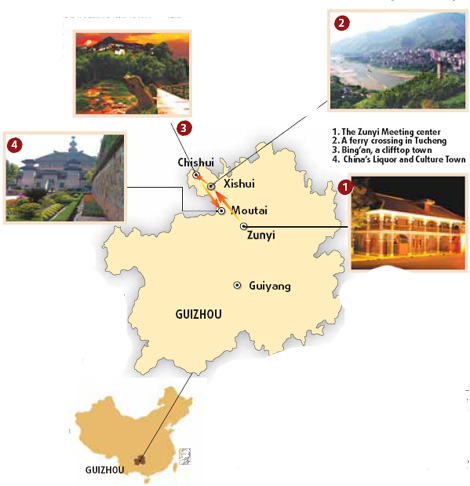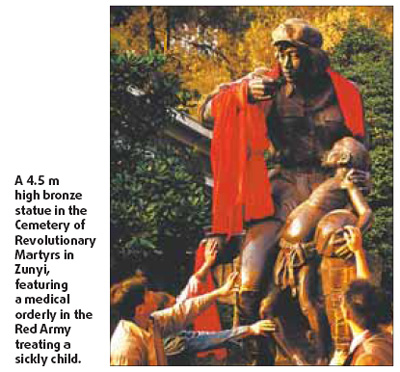Zunyi: the city that decided the fate of modern China
Updated: 2009-09-25 08:28
By Tony Murray(China Daily)
|
|||||||||||
Decisions that have repercussions throughout the rest of our lives are often made in the strangest of places - in the back of a car, a subway platform, at the third table from the left in the local KFC or even in the WC. Decisions that affect the fate of nations are often reached in the unlikeliest of settings too.
Take Zunyi, an 800,000-strong city in the southwestern province of Guizhou. Today it is a welcoming, tourist-friendly prefecture level city, whose high street is lined with stores offering an eclectic mix of the latest in Western and Chinese brands. Some 74 years ago it was a very different story, as the city provided the backdrop to one of the most dramatic episodes in twentieth century Chinese history.
It was here, in January 1935 that the leaders of the bedraggled Red Army met to mull over their sundry defeats by the Chiang Kai-Shek-led KMT in the Jiangxi region and to decide on their future strategy. Following the meeting, Mao Zedong emerged as the leader of the CPC and the rest, as they say, is history. With a big "H".
Zunyi wears its role in shaping modern China quite self-consciously. At its core is the Zunyi conference museum, a celebration of the city's role in the decisive battles that ultimately saw the CPC emerge as triumphant and take control of China.
For non-Chinese speakers, it's best to take along a translator as most of the materials (and the guides) are only available in Chinese. For the most part, though, the images, photographs and artworks speak for themselves and depict a youthful cadre of keen young Red Army officers whose names can now be reeled off by every schoolboy in China.
The museum is currently being revamped but, when it soon re-opens, it will provide a fine introduction for those looking to learn a little more about the crucial events of the mid-1930s and an entertaining romp through the sundry machinations that Mao used to confound his opponents, both internally and externally.
Aside from the museum, Zunyi's other testament to its role in history is its monument to the Red Army Martyrs. Perched at the top of the ubiquitous stone stairway that will become all too familiar to visitors the area, this Soviet-style hammer-and-sickled column has now become a place almost of pilgrimage. Even on a rain-swept morning, as early as 7 am, you can see a trickle of visitors braving the steps to inspect the calligraphy of Deng Xiaoping and his message to the long departed Long Marchers: "Long Live the Red Army Revolutionary Martyrs".
Another, less accessible, visitor attraction is the Hai Long Tun Fortress. One for the more hardy rambler, this medieval fortress is only reachable after negotiating a lengthy pathway and several stone staircases. Its very inaccessibility is the key to why it remained inviolate for some 500 years, defying a succession of emperors to bring its private fiefdom within the greater China.
It's back to the Red Army motif in Tucheng, a small township on the route between Zunyi and Xishui, home to the Red Army Crossing Museum, a celebration of the four river crossings initiated by Mao to elude the pursuing KMT forces. Across the way from the museum is the old town, once home to the PRC leader and Zhou Enlai whilst they planned their military strategy.
From there its onwards to Chishui, but it's well worth stopping en route at Bing'an, possibly one of the most picturesque villages in the area. Access to Bing'an is across a narrow stone bridge that offers a fantastic opportunity for would-be photographers to capture the cliff-top village, the waterfall that runs beneath and the breathtaking river valley below.
Legend has it that the village name, at one time, incorporated the Chinese character for fire and, several centuries ago, the village was consumed by an inferno, leaving just one residence untouched. The superstitious villagers then changed the town's name and, just to be on the safe side, incorporated the character for water. Perhaps somewhat predictably, the village was then devastated by a flood. Today the villagers have expunged both characters from the village's name and, maybe coincidentally, seem to be thriving.
It is impossible to walk through this sequestered community without pondering what it would be like to live there, removed from everyday concerns and with a waterfall on your doorstep.
From Xishui it is just a short trip to Moutai, a name that will be familiar to anyone press-ganged into an official Chinese business dinner. The locals pride themselves on how frequently their brand of Baijiu is counterfeited, seeing themselves as the Krug of the Chinese spirit world. Those of you familiar with the rasping burn of the brand's low-grade counterparts will be pleasantly surprised by the quality of the real thing.
Sampling the spirit is a compulsory part of lunch in the area and is unavoidable if dining with any of the locals. Rumor has it that, at the height of the production cycle - the distillery now produces 20,000 tons of liquor a year - the very air is intoxicating. Still other visitors talk of being offered bowls of the 53 percent brew over breakfast - snap crackle and hic.
Although the distillery itself is out of bounds to most visitors, its attendant museum is open to all. Here there is a chance to see many of the 20th century's leading politicians - and one time British prime minister, John Major - sampling China's most famous brew. It also shows how the distillery grew from a collection of shacks in the 1930s to the state-of-the-art spirit producing apparatus it is today.
From Moutai, complete with its eye-catching monument to Mao's four crossings, it's on to Chishui, the second string in the region's "red" tourism offering. Although ostensibly referring to the region's seven-decade-old ties to the victory of the Red Army, the term could equally well apply to the Danxia (literally "red rock") zone that surrounds the city.
Due to a geological anomaly, much of the landscape in the area is preserved pretty much in the form it would have taken 65 million years ago in the Cretaceous period. This applies as much to the region's flora and fauna as it does to its rock formations, with the area being home to countless rare animals, insects and plant species - including a variety of fern said to be among the oldest in the world.
The scenery is undoubtedly breathtaking, with a personal favorite being the great Chishui Waterfall. This majestic feature will move even the most cynical of non-nature lovers and will reduce them to babbling about its beauty for months to come.
For those looking for something to more actively participate in, the region is also the traditional home of a particularly esoteric form of bamboo rafting. Not for the hardy natives of these parts the luxury of multiple bamboo tubes bound together with water-resistant cord, instead they opt for a single piece of lengthy bamboo to balance on. Whilst the balancing along would be a feat beyond most, those adept in the sport can race, hurdle and jump between bamboo rods without falling in, well not all that often anyway.
Both alphabetically and traditionally, Zunyi is far from the top of the list when it comes to tourist destinations, but the residents of the area are becoming fully aware of the attractions of this compelling region. It caters to cultural, geological and alcohol-inclined tourists and is set to emerge as one of China's "must-see" visitor centers.


(China Daily 09/25/2009 page12)